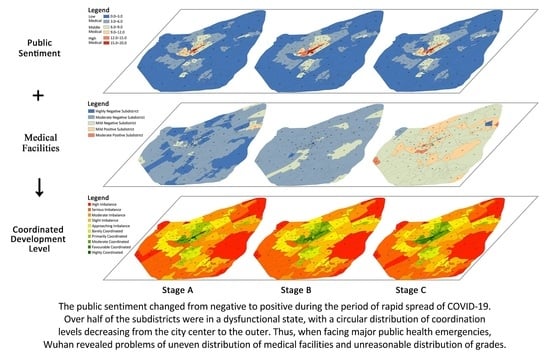Dynamic Demand Evaluation of COVID-19 Medical Facilities in Wuhan Based on Public Sentiment
Abstract
:1. Introduction
2. Materials and Methods
2.1. Study Area
2.2. Data Sources
2.2.1. Weibo Data
2.2.2. Medical Facilities Data
2.3. Methods
2.3.1. Extraction of Weibo Data Related to COVID-19
2.3.2. Determination of the Sentimental Polarity of Weibo Texts
2.3.3. Kernel Density Analysis of Sentimental Points and Medical Facilities
2.3.4. Measurement of the Coordinated Relationship between Public Sentiment and Medical Facilities
3. Results
3.1. Trend in Public Attention of COVID-19 Epidemic
3.2. Trend in Sentimental Polarity
3.3. Spatial Distribution of Emotional Points and Medical Facilities
3.3.1. Kernel Density of Emotional Points
3.3.2. Kernel Density of Medical Facilities
3.4. Coordinated Development Level Evaluation of Public Sentiment and Medical Facilities
3.4.1. Sentimental Value Distribution
3.4.2. Medical Facility Coverage Ratio Distribution
3.4.3. Coordinated Development Level Evaluation
4. Discussion
- (1)
- Weibo users are not representative of all Wuhan residents during the COVID-19 pandemic. According to the 2020 Weibo User Development Report [58], most Weibo users are between the ages of 20 and 30, accounting for 48% of the population. In contrast, according to the Wuhan Statistical Yearbook 2021 [90], the proportion of 20- to 30-year-olds in the total population of Wuhan is 14%. The way the information is shared may vary by gender and age. Since few of the social media users are elderly or children, social media data cannot fully reflect public sentiment. Further research considering the diversity of data sources is needed to obtain more extensive and accurate conclusions. In addition, given that there is evidence to suggest that cultural background and household situation can influence perceptions and experiences with the health system [91,92], we will aim to include such questions in similar future surveys.
- (2)
- Due to the diverse forms of expression in Chinese, the use of emotion dictionaries to determine the emotional polarity of text cannot fully identify the emotion expressed by the user, and future research could use methods, such as machine learning, to capture emotion accurately.
- (3)
- Many factors can affect the evaluation of the configuration of medical facilities. Besides considering public sentiment, there are some other variables that cannot be ignored, such as urban population distribution, spatial accessibility, urban spatial development level, actual medical behaviour of residents, spatial spread of COVID-19 epidemics, etc. In the future research, we will further improve the methods and ideas, explore the influence of other factors and the relationship between them, and provide decision reference for the fine layout and function enhancement of perfect urban medical facilities.
5. Conclusions
Author Contributions
Funding
Institutional Review Board Statement
Informed Consent Statement
Data Availability Statement
Conflicts of Interest
References
- Chinese Center for Disease Control and Prevention. Available online: https://www.chinacdc.cn/en/COVID19/index_1.html (accessed on 19 March 2022).
- Li, X.; Zhou, L.; Jia, T.; Peng, R.; Fu, X.; Zou, Y. Associating COVID-19 Severity with Urban Factors: A Case Study of Wuhan. Int. J. Environ. Res. Public Health 2020, 17, 6712. [Google Scholar] [CrossRef] [PubMed]
- WHO. Coronavirus (COVID-19) Dashboard. Available online: https://covid19.who.int (accessed on 16 February 2022).
- Zhou, F.; Yu, T.; Du, R.; Fan, G.; Liu, Y.; Liu, Z.; Xiang, J.; Wang, Y.; Song, B.; Gu, X.; et al. Clinical course and risk factors for mortality of adult inpatients with COVID-19 in Wuhan, China: A retrospective cohort study. Lancet 2020, 395, 1054–1062. [Google Scholar] [CrossRef]
- Mehta, P.; McAuley, D.F.; Brown, M.; Sanchez, E.; Tattersall, R.S.; Manson, J.J. COVID-19: Consider cytokine storm syndromes and immunosuppression. Lancet 2020, 395, 1033–1034. [Google Scholar] [CrossRef]
- Lee, V.J.; Aguilera, X.; Heymann, D.; Wilder-Smith, A.; Lee, V.J.; Aguilera, X.; Heymann, D.L.; Wilder-Smith, A.; Bausch, D.G.; Briand, S.; et al. Preparedness for emerging epidemic threats: A Lancet Infectious Diseases Commission. Lancet Infect. Dis. 2020, 20, 17–19. [Google Scholar] [CrossRef] [Green Version]
- Chan, J.F.-W.; Yuan, S.; Kok, K.-H.; To, K.K.-W.; Chu, H.; Yang, J.; Xing, F.; Liu, J.; Yip, C.C.-Y.; Poon, R.W.-S.; et al. A familial cluster of pneumonia associated with the 2019 novel coronavirus indicating person-to-person transmission: A study of a family cluster. Lancet 2020, 395, 514–523. [Google Scholar] [CrossRef] [Green Version]
- Huang, C.; Wang, Y.; Li, X.; Ren, L.; Zhao, J.; Hu, Y.; Zhang, L.; Fan, G.; Xu, J.; Gu, X.; et al. Clinical features of patients infected with 2019 novel coronavirus in Wuhan, China. Lancet 2020, 395, 497–506. [Google Scholar] [CrossRef] [Green Version]
- Baloch, G.M.; Kamaludin, K.; Chinna, K.; Sundarasen, S.; Nurunnabi, M.; Khoshaim, H.B.; Hossain, S.F.A.; Sukayt, A.A.; Baloch, L.G. Coping with COVID-19: The Strategies Adapted by Pakistani Students to Overcome Implications. Int. J. Environ. Res. Public Health 2021, 18, 1799. [Google Scholar] [CrossRef]
- Ripon, R.K.; Mim, S.S.; Puente, A.E.; Hossain, S.; Babor, M.M.H.; Sohan, S.A.; Islam, N. COVID-19: Psychological effects on a COVID-19 quarantined population in Bangladesh. Heliyon 2020, 6, e05481. [Google Scholar] [CrossRef]
- Dsouza, D.D.; Quadros, S.; Hyderabadwala, Z.J.; Mamun, M.A. Aggregated COVID-19 suicide incidences in India: Fear of COVID-19 infection is the prominent causative factor. Psychiatry Res. 2020, 290, 113145. [Google Scholar] [CrossRef]
- Kubo, T.; Sugawara, D.; Masuyama, A. The effect of ego-resiliency and COVID-19-related stress on mental health among the Japanese population. Personal. Individ. Differ. 2021, 175, 110702. [Google Scholar] [CrossRef]
- Wasdani, K.P.; Prasad, A. The impossibility of social distancing among the urban poor: The case of an Indian slum in the times of COVID-19. Local Environ. 2020, 25, 414–418. [Google Scholar] [CrossRef]
- Oliveira, L.A.; Aguiar Arantes, R. Neighborhood Effects and Urban Inequalities: The Impact of COVID-19 on the Periphery of Salvador, Brazil. City Soc. 2020, 32, ciso.12266. [Google Scholar] [CrossRef] [PubMed]
- Qiu, Y.; Chen, X.; Shi, W. Impacts of social and economic factors on the transmission of coronavirus disease 2019 (COVID-19) in China. J. Popul. Econ. 2020, 33, 1127–1172. [Google Scholar] [CrossRef]
- Connolly, C.; Ali, S.H.; Keil, R. On the relationships between COVID-19 and extended urbanization. Dialogues Hum. Geogr. 2020, 10, 213–216. [Google Scholar] [CrossRef]
- Chen, B.; Marvin, S.; While, A. Containing COVID-19 in China: AI and the robotic restructuring of future cities. Dialogues Hum. Geogr. 2020, 10, 238–241. [Google Scholar] [CrossRef]
- Haslam, S.A.; Steffens, N.K.; Reicher, S.D.; Bentley, S.V. Identity Leadership in a Crisis: A 5R Framework for Learning from Responses to COVID-19. Soc. Issues Policy Rev. 2021, 15, 35–83. [Google Scholar] [CrossRef] [PubMed]
- Sergent, K.; Stajkovic, A.D. Women’s leadership is associated with fewer deaths during the COVID-19 crisis: Quantitative and qualitative analyses of United States governors. J. Appl. Psychol. 2020, 105, 771–783. [Google Scholar] [CrossRef]
- Kang, D.; Choi, H.; Kim, J.-H.; Choi, J. Spatial epidemic dynamics of the COVID-19 outbreak in China. Int. J. Infect. Dis. 2020, 94, 96–102. [Google Scholar] [CrossRef]
- Huang, R.; Liu, M.; Ding, Y. Spatial-temporal distribution of COVID-19 in China and its prediction: A data-driven modeling analysis. J. Infect. Dev. Ctries. 2020, 14, 246–253. [Google Scholar] [CrossRef] [Green Version]
- Zhang, J.; Zheng, Z.; Zhang, L.; Qin, Y.; Duan, J.; Zhang, A. Influencing Factors of Environmental Risk Perception during the COVID-19 Epidemic in China. Int. J. Environ. Res. Public Health 2021, 18, 9375. [Google Scholar] [CrossRef]
- Huang, Q.; Liu, Q.; Song, C.; Liu, X.; Shu, H.; Wang, X.; Liu, Y.; Chen, X.; Chen, J.; Pei, T. Urban spatial epidemic simulation model: A case study of the second COVID-19 outbreak in Beijing, China. Trans. GIS 2022, 26, 297–316. [Google Scholar] [CrossRef] [PubMed]
- Han, L.; Jia, J. Reductions of migrant population reduces the number of COVID-19 epidemic: A case study in China. Environ. Sci. Pollut. Res. 2021, 28, 58364–58374. [Google Scholar] [CrossRef] [PubMed]
- Irandoost, K.; Alizadeh, H.; Yousefi, Z.; Shahmoradi, B. Spatial analysis of population density and its effects during the COVID-19 pandemic in Sanandaj, Iran. J. Asian Archit. Build. Eng. 2022, 1–8. [Google Scholar] [CrossRef]
- Ganasegeran, K.; Jamil, M.F.A.; Ch’ng, A.S.H.; Looi, I.; Peariasamy, K.M. Influence of Population Density for COVID-19 Spread in Malaysia: An Ecological Study. Int. J. Environ. Res. Public Health 2021, 18, 9866. [Google Scholar] [CrossRef]
- Yilmaz, M.; Ulubaş Hamurcu, A. Relationships between socio-demographic structure and spatio-temporal distribution patterns of COVID-19 cases in Istanbul, Turkey. Int. J. Urban Sci. 2022, 1–25. [Google Scholar] [CrossRef]
- Boon-Itt, S.; Skunkan, Y. Public Perception of the COVID-19 Pandemic on Twitter: Sentiment Analysis and Topic Modeling Study. JMIR Public Health Surveill. 2020, 6, e21978. [Google Scholar] [CrossRef]
- Wang, J.; Zhou, Y.; Zhang, W.; Evans, R.; Zhu, C. Concerns Expressed by Chinese Social Media Users During the COVID-19 Pandemic: Content Analysis of Sina Weibo Microblogging Data. J. Med. Internet Res. 2020, 22, e22152. [Google Scholar] [CrossRef]
- Wu, J.T.; Leung, K.; Leung, G.M. Nowcasting and forecasting the potential domestic and international spread of the 2019-nCoV outbreak originating in Wuhan, China: A modelling study. Lancet 2020, 395, 689–697. [Google Scholar] [CrossRef] [Green Version]
- Qian, Y.; Hanser, A. How did Wuhan residents cope with a 76-day lockdown? Chin. Sociol. Rev. 2021, 53, 55–86. [Google Scholar] [CrossRef]
- Zheng, L.; Miao, M.; Lim, J.; Li, M.; Nie, S.; Zhang, X. Is Lockdown Bad for Social Anxiety in COVID-19 Regions?: A National Study in The SOR Perspective. Int. J. Environ. Res. Public Health 2020, 17, 4561. [Google Scholar] [CrossRef]
- Su, Y.; Xue, J.; Liu, X.; Wu, P.; Chen, J.; Chen, C.; Liu, T.; Gong, W.; Zhu, T. Examining the Impact of COVID-19 Lockdown in Wuhan and Lombardy: A Psycholinguistic Analysis on Weibo and Twitter. Int. J. Environ. Res. Public Health 2020, 17, 4552. [Google Scholar] [CrossRef] [PubMed]
- Sun, N.; Wei, L.; Shi, S.; Jiao, D.; Song, R.; Ma, L.; Wang, H.; Wang, C.; Wang, Z.; You, Y.; et al. A qualitative study on the psychological experience of caregivers of COVID-19 patients. Am. J. Infect. Control 2020, 48, 592–598. [Google Scholar] [CrossRef] [PubMed]
- Petzold, M.B.; Plag, J.; Ströhle, A. Umgang mit psychischer Belastung bei Gesundheitsfachkräften im Rahmen der COVID-19-Pandemie. Nervenarzt 2020, 91, 417–421. [Google Scholar] [CrossRef] [Green Version]
- Jungmann, S.M.; Witthöft, M. Health anxiety, cyberchondria, and coping in the current COVID-19 pandemic: Which factors are related to coronavirus anxiety? J. Anxiety Disord. 2020, 73, 102239. [Google Scholar] [CrossRef] [PubMed]
- Li, S.; Wang, Y.; Xue, J.; Zhao, N.; Zhu, T. The Impact of COVID-19 Epidemic Declaration on Psychological Consequences: A Study on Active Weibo Users. Int. J. Environ. Res. Public Health 2020, 17, 2032. [Google Scholar] [CrossRef] [Green Version]
- Duan, L.; Shao, X.; Wang, Y.; Huang, Y.; Miao, J.; Yang, X.; Zhu, G. An investigation of mental health status of children and adolescents in china during the outbreak of COVID-19. J. Affect. Disord. 2020, 275, 112–118. [Google Scholar] [CrossRef]
- Losada-Baltar, A.; Jiménez-Gonzalo, L.; Gallego-Alberto, L.; Pedroso-Chaparro, M.d.S.; Fernandes-Pires, J.; Márquez-González, M. “We Are Staying at Home”. Association of Self-perceptions of Aging, Personal and Family Resources, and Loneliness With Psychological Distress During the Lock-Down Period of COVID-19. J. Gerontol. Ser. B 2021, 76, e10–e16. [Google Scholar] [CrossRef] [Green Version]
- Raamkumar, A.S.; Tan, S.G.; Wee, H.L. Measuring the Outreach Efforts of Public Health Authorities and the Public Response on Facebook During the COVID-19 Pandemic in Early 2020: Cross-Country Comparison. J. Med. Internet Res. 2020, 22, e19334. [Google Scholar] [CrossRef]
- Sakti, A.M.T.; Mohamad, E.; Azlan, A.A. Mining of Opinions on COVID-19 Large-Scale Social Restrictions in Indonesia: Public Sentiment and Emotion Analysis on Online Media. J. Med. Internet Res. 2021, 23, e28249. [Google Scholar] [CrossRef]
- Zhu, B.; Zheng, X.; Liu, H.; Li, J.; Wang, P. Analysis of spatiotemporal characteristics of big data on social media sentiment with COVID-19 epidemic topics. Chaos Solitons Fractals 2020, 140, 110123. [Google Scholar] [CrossRef]
- Ma, Y.; Yang, Y.; Jiao, H. Exploring the Impact of Urban Built Environment on Public Emotions Based on Social Media Data: A Case Study of Wuhan. Land 2021, 10, 986. [Google Scholar] [CrossRef]
- Wontorczyk, A.; Rożnowski, B. Remote, Hybrid, and On-Site Work during the SARS-CoV-2 Pandemic and the Consequences for Stress and Work Engagement. Int. J. Environ. Res. Public Health 2022, 19, 2400. [Google Scholar] [CrossRef] [PubMed]
- Chae, J.; Thom, D.; Jang, Y.; Kim, S.; Ertl, T.; Ebert, D.S. Public behavior response analysis in disaster events utilizing visual analytics of microblog data. Comput. Graph. 2014, 38, 51–60. [Google Scholar] [CrossRef]
- Stieglitz, S.; Mirbabaie, M.; Ross, B.; Neuberger, C. Social media analytics—Challenges in topic discovery, data collection, and data preparation. Int. J. Inf. Manag. 2018, 39, 156–168. [Google Scholar] [CrossRef]
- Li, C.; Chen, L.J.; Chen, X.; Zhang, M.; Pang, C.P.; Chen, H. Retrospective analysis of the possibility of predicting the COVID-19 outbreak from Internet searches and social media data, China, 2020. Eurosurveillance 2020, 25, 2000199. [Google Scholar] [CrossRef]
- Resch, B.; Usländer, F.; Havas, C. Combining machine-learning topic models and spatiotemporal analysis of social media data for disaster footprint and damage assessment. Cartogr. Geogr. Inf. Sci. 2018, 45, 362–376. [Google Scholar] [CrossRef] [Green Version]
- Jeong, B.; Yoon, J.; Lee, J.-M. Social media mining for product planning: A product opportunity mining approach based on topic modeling and sentiment analysis. Int. J. Inf. Manag. 2019, 48, 280–290. [Google Scholar] [CrossRef]
- Han, X.; Wang, J.; Zhang, M.; Wang, X. Using Social Media to Mine and Analyze Public Opinion Related to COVID-19 in China. Int. J. Environ. Res. Public Health 2020, 17, 2788. [Google Scholar] [CrossRef] [Green Version]
- Meo, R.; Sulis, E. Processing Affect in Social Media: A Comparison of Methods to Distinguish Emotions in Tweets. ACM Trans. Internet Technol. 2017, 17, 1–25. [Google Scholar] [CrossRef]
- Wuhan Statistical Yearbook 2020. Available online: http://tjj.wuhan.gov.cn/tjfw/tjnj/202102/t20210202_1624450.shtml (accessed on 19 March 2022).
- Liu, L.; Peng, Z.; Wu, H.; Jiao, H.; Yu, Y.; Zhao, J. Fast Identification of Urban Sprawl Based on K-Means Clustering with Population Density and Local Spatial Entropy. Sustainability 2018, 10, 2683. [Google Scholar] [CrossRef] [Green Version]
- Wang, W.; Tang, J.; Wei, F. Updated understanding of the outbreak of 2019 novel coronavirus (2019-nCoV) in Wuhan, China. J. Med. Virol. 2020, 92, 441–447. [Google Scholar] [CrossRef] [PubMed] [Green Version]
- Update on the New Coronavirus Disease Outbreak as of 24:00 on April 8. Available online: http://www.nhc.gov.cn/xcs/yqtb/202004/fa7bb40a7fbf4b2c8f3989d512fe5b77.shtml (accessed on 17 March 2022).
- Xu, G.; Jiao, L.; Zhao, S.; Yuan, M.; Li, X.; Han, Y.; Zhang, B.; Dong, T. Examining the Impacts of Land Use on Air Quality from a Spatio-Temporal Perspective in Wuhan, China. Atmosphere 2016, 7, 62. [Google Scholar] [CrossRef] [Green Version]
- Bing, N.C. The Residents’ Committee in China’s Political System: Democracy, Stability, Mobilization. Issues Stud. 2012, 48, 71–126. [Google Scholar]
- 2020 Weibo User Development Report. Available online: https://data.weibo.com/report/reportDetail?id=456 (accessed on 5 May 2022).
- Yi, J.; Gina Qu, J.; Zhang, W.J. Depicting the Emotion Flow: Super-Spreaders of Emotional Messages on Weibo During the COVID-19 Pandemic. Soc. Media Soc. 2022, 8, 20563051221084950. [Google Scholar] [CrossRef]
- Wuhan Lifted the Control of the Channel from Wuhan Today. Available online: http://news.cctv.com/2020/04/08/ARTIAbCIGDvcvzwIFkJrtsfM200408.shtml (accessed on 19 March 2022).
- Notice on the Issuance of the Basic Standards for Medical Institutions (for Trial Implementation). Available online: http://www.nhc.gov.cn/yzygj/s3576/201706/4d84820f321144c290ddaacba53cb590.shtml (accessed on 17 March 2022).
- Li, L.; Du, T.; Hu, Y. The effect of different classification of hospitals on medical expenditure from perspective of classification of hospitals framework: Evidence from China. Cost Eff. Resour. Alloc. 2020, 18, 35. [Google Scholar] [CrossRef]
- Chen, S.; Zhang, Z.; Yang, J.; Wang, J.; Zhai, X.; Bärnighausen, T.; Wang, C. Fangcang shelter hospitals: A novel concept for responding to public health emergencies. Lancet 2020, 395, 1305–1314. [Google Scholar] [CrossRef]
- Haddi, E.; Liu, X.; Shi, Y. The Role of Text Pre-processing in Sentiment Analysis. Procedia Comput. Sci. 2013, 17, 26–32. [Google Scholar] [CrossRef] [Green Version]
- Gao, Y.; Wang, S.; Padmanabhan, A.; Yin, J.; Cao, G. Mapping spatiotemporal patterns of events using social media: A case study of influenza trends. Int. J. Geogr. Inf. Sci. 2018, 32, 425–449. [Google Scholar] [CrossRef]
- Wu, J.; Lu, K.; Su, S.; Wang, S. Chinese Micro-Blog Sentiment Analysis Based on Multiple Sentiment Dictionaries and Semantic Rule Sets. IEEE Access 2019, 7, 183924–183939. [Google Scholar] [CrossRef]
- Ma, Y.; Ling, C.; Wu, J. Exploring the Spatial Distribution Characteristics of Emotions of Weibo Users in Wuhan Waterfront Based on Gender Differences Using Social Media Texts. ISPRS Int. J. Geo-Inf. 2020, 9, 465. [Google Scholar] [CrossRef]
- Elson, R.; Davies, T.M.; Lake, I.R.; Vivancos, R.; Blomquist, P.B.; Charlett, A.; Dabrera, G. The spatio-temporal distribution of COVID-19 infection in England between January and June 2020. Epidemiol. Infect. 2021, 149, e73. [Google Scholar] [CrossRef] [PubMed]
- Shi, W.; Tong, C.; Zhang, A.; Wang, B.; Shi, Z.; Yao, Y.; Jia, P. An extended Weight Kernel Density Estimation model forecasts COVID-19 onset risk and identifies spatiotemporal variations of lockdown effects in China. Commun. Biol. 2021, 4, 126. [Google Scholar] [CrossRef] [PubMed]
- Announcement of the Ministry of Housing and Urban-Rural Development on the Release of the Standard for Urban Residential Area Planning and Design. Available online: https://www.mohurd.gov.cn/gongkai/fdzdgknr/tzgg/201811/20181130_238590.html (accessed on 18 March 2022).
- Yuan, Y.; Jin, M.; Ren, J.; Hu, M.; Ren, P. The Dynamic Coordinated Development of a Regional Environment-Tourism-Economy System: A Case Study from Western Hunan Province, China. Sustainability 2014, 6, 5231. [Google Scholar] [CrossRef] [Green Version]
- Xiong, Y. Uncertainty evaluation of the coordinated development of urban human settlement environment and economy in Changsha city. J. Geogr. Sci. 2011, 21, 1123–1137. [Google Scholar] [CrossRef]
- Rong, P.; Zheng, Z.; Kwan, M.-P.; Qin, Y. Evaluation of the spatial equity of medical facilities based on improved potential model and map service API: A case study in Zhengzhou, China. Appl. Geogr. 2020, 119, 102192. [Google Scholar] [CrossRef]
- Cheng, M.; Tao, L.; Lian, Y.; Huang, W. Measuring Spatial Accessibility of Urban Medical Facilities: A Case Study in Changning District of Shanghai in China. Int. J. Environ. Res. Public Health 2021, 18, 9598. [Google Scholar] [CrossRef]
- Zhou, Z.; Xu, Z.; Liu, A.; Zhou, S.; Mu, L.; Zhang, X. Mapping the Accessibility of Medical Facilities of Wuhan during the COVID-19 Pandemic. ISPRS Int. J. Geo-Inf. 2021, 10, 318. [Google Scholar] [CrossRef]
- Wang, C.; Deng, Y.; Yuan, Z.; Zhang, C.; Zhang, F.; Cai, Q.; Gao, C.; Kurths, J. How to Optimize the Supply and Allocation of Medical Emergency Resources During Public Health Emergencies. Front. Phys. 2020, 8, 383. [Google Scholar] [CrossRef]
- Cao, Y.; Zhen, F.; Wu, H. Public Transportation Environment and Medical Choice for Chronic Disease: A Case Study of Gaoyou, China. Int. J. Environ. Res. Public Health 2019, 16, 1612. [Google Scholar] [CrossRef] [Green Version]
- Fu, S.; Liu, Y.; Fang, Y. Measuring the Differences of Public Health Service Facilities and Their Influencing Factors. Land 2021, 10, 1225. [Google Scholar] [CrossRef]
- McQuilkin, P.A.; Udhayashankar, K.; Niescierenko, M.; Maranda, L. Health-Care Access during the Ebola Virus Epidemic in Liberia. Am. J. Trop. Med. Hyg. 2017, 97, 931–936. [Google Scholar] [CrossRef] [PubMed] [Green Version]
- Hulland, E.N.; Wiens, K.E.; Shirude, S.; Morgan, J.D.; Bertozzi-Villa, A.; Farag, T.H.; Fullman, N.; Kraemer, M.U.G.; Miller-Petrie, M.K.; Gupta, V.; et al. Travel time to health facilities in areas of outbreak potential: Maps for guiding local preparedness and response. BMC Med. 2019, 17, 232. [Google Scholar] [CrossRef] [PubMed] [Green Version]
- Casas, I.; Delmelle, E. Landscapes of healthcare utilization during a dengue fever outbreak in an urban environment of Colombia. Environ. Monit. Assess. 2019, 191, 279. [Google Scholar] [CrossRef] [PubMed]
- Casas, I.; Delmelle, E.; Delmelle, E.C. Potential versus revealed access to care during a dengue fever outbreak. J. Transp. Health 2017, 4, 18–29. [Google Scholar] [CrossRef]
- Sun, K.; Cai, Y.; Lin, S.; Wang, S.; Wang, C. Research on the Elastic Development of Spatial Layout of Hospitals Based on GIS Platform under COVID-19 Background: A Case Study of Wuhan. In Proceedings of the ICCREM 2021: Challenges of the Construction Industry under the Pandemic, Beijing, China, 16–17 October 2021; Wang, Y., Zhang, D., Shen, G.Q.P., Eds.; American Society of Civil Engineers: New York, NY, USA, 2021; pp. 10–29. [Google Scholar]
- Chen, B.Y.; Wang, Y.; Wang, D.; Li, Q.; Lam, W.H.K.; Shaw, S.-L. Understanding the Impacts of Human Mobility on Accessibility Using Massive Mobile Phone Tracking Data. Ann. Am. Assoc. Geogr. 2018, 108, 1115–1133. [Google Scholar] [CrossRef]
- Cheng, G.; Zeng, X.; Duan, L.; Lu, X.; Sun, H.; Jiang, T.; Li, Y. Spatial difference analysis for accessibility to high level hospitals based on travel time in Shenzhen, China. Habitat Int. 2016, 53, 485–494. [Google Scholar] [CrossRef] [Green Version]
- Ellis, L.A.; Pomare, C.; Gillespie, J.A.; Root, J.; Ansell, J.; Holt, J.; Wells, L.; Tran, Y.; Braithwaite, J.; Zurynski, Y. Changes in public perceptions and experiences of the Australian health-care system: A decade of change. Health Expect. 2021, 24, 95–110. [Google Scholar] [CrossRef]
- Liu, T.; Ma, Y.; Yang, X. Service Quality Improvement of Hospital Reservation System Based on Text Sentiment Analysis. In Proceedings of the 2018 9th International Conference on Information Technology in Medicine and Education (ITME), Hangzhou, China, 19–21 October 2018; pp. 289–293. [Google Scholar]
- Huppertz, J.W.; Otto, P. Predicting HCAHPS scores from hospitals’ social media pages: A sentiment analysis. Health Care Manag. Rev. 2018, 43, 359–367. [Google Scholar] [CrossRef]
- Zhu, Y.; Cao, L.; Xie, J.; Yu, Y.; Chen, A.; Huang, F. Using social media data to assess the impact of COVID-19 on mental health in China. Psychol. Med. 2021, 1–8. [Google Scholar] [CrossRef]
- Wuhan Statistical Yearbook. 2021. Available online: http://tjj.wuhan.gov.cn/tjfw/tjnj/202112/t20211220_1877108.shtml (accessed on 5 May 2022).
- Xu, B.; Fochsen, G.; Xiu, Y.; Thorson, A.; Kemp, J.R.; Jiang, Q.W. Perceptions and experiences of health care seeking and access to TB care—A qualitative study in Rural Jiangsu Province, China. Health Policy 2004, 69, 139–149. [Google Scholar] [CrossRef] [Green Version]
- O’Mahony, J.M.; Donnelly, T.T. The Influence of Culture on Immigrant Women’s Mental Health Care Experiences from the Perspectives of Health Care Providers. Issues Ment. Health Nurs. 2007, 28, 453–471. [Google Scholar] [CrossRef] [PubMed]
- Wang, F.; Fang, Y.; Deng, H.; Wei, F. How Community Medical Facilities Can Promote Resilient Community Constructions under the Background of Pandemics. 2022. Available online: https://journals.sagepub.com/doi/10.1177/1420326X211048537 (accessed on 7 May 2022).
- Opinions of the CPC Central Committee and the State Council on Further Strengthening the Administration of Urban Planning and Construction. Available online: http://www.gov.cn/zhengce/2016-02/21/content_5044367.htm (accessed on 5 May 2022).
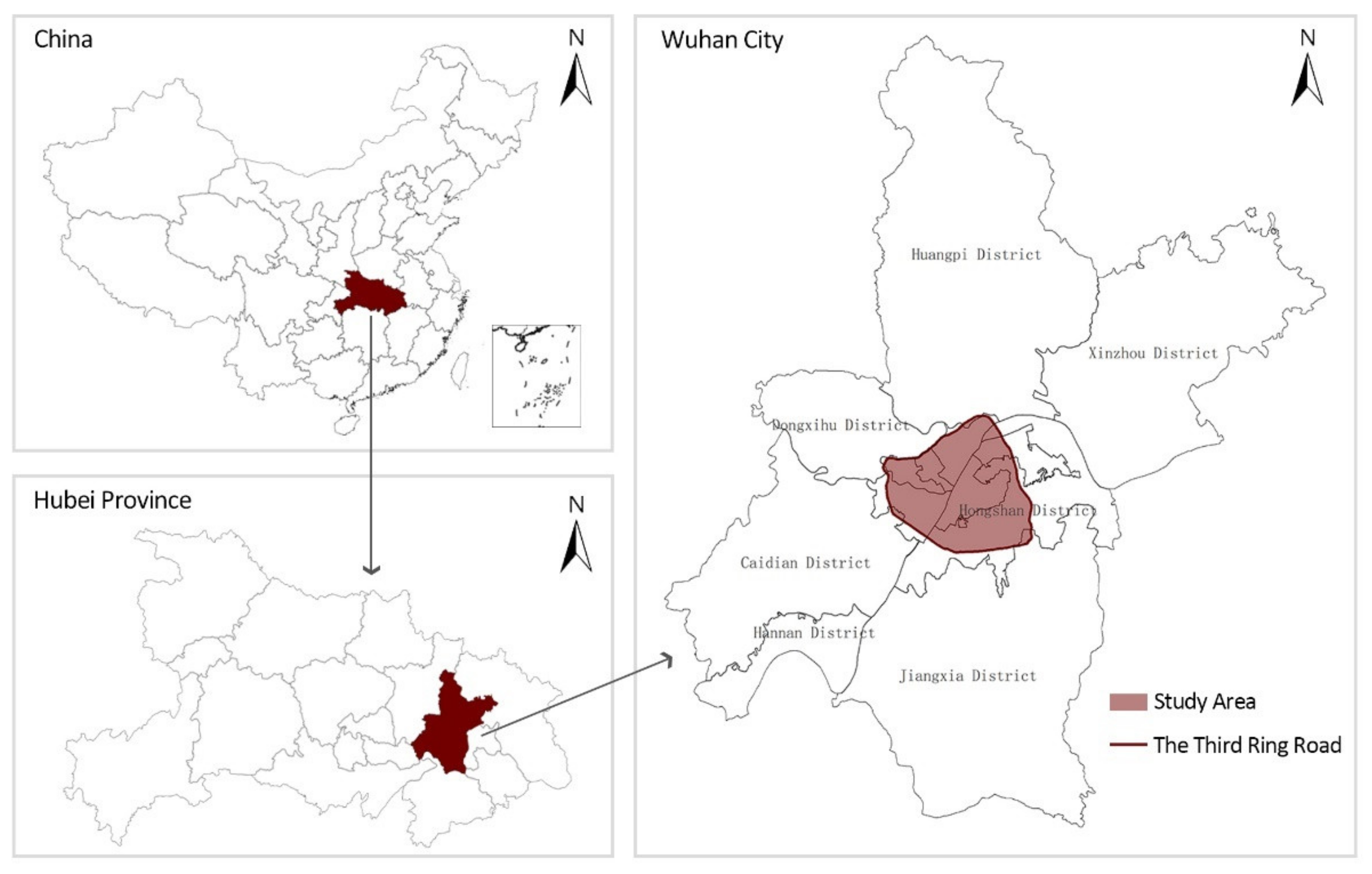

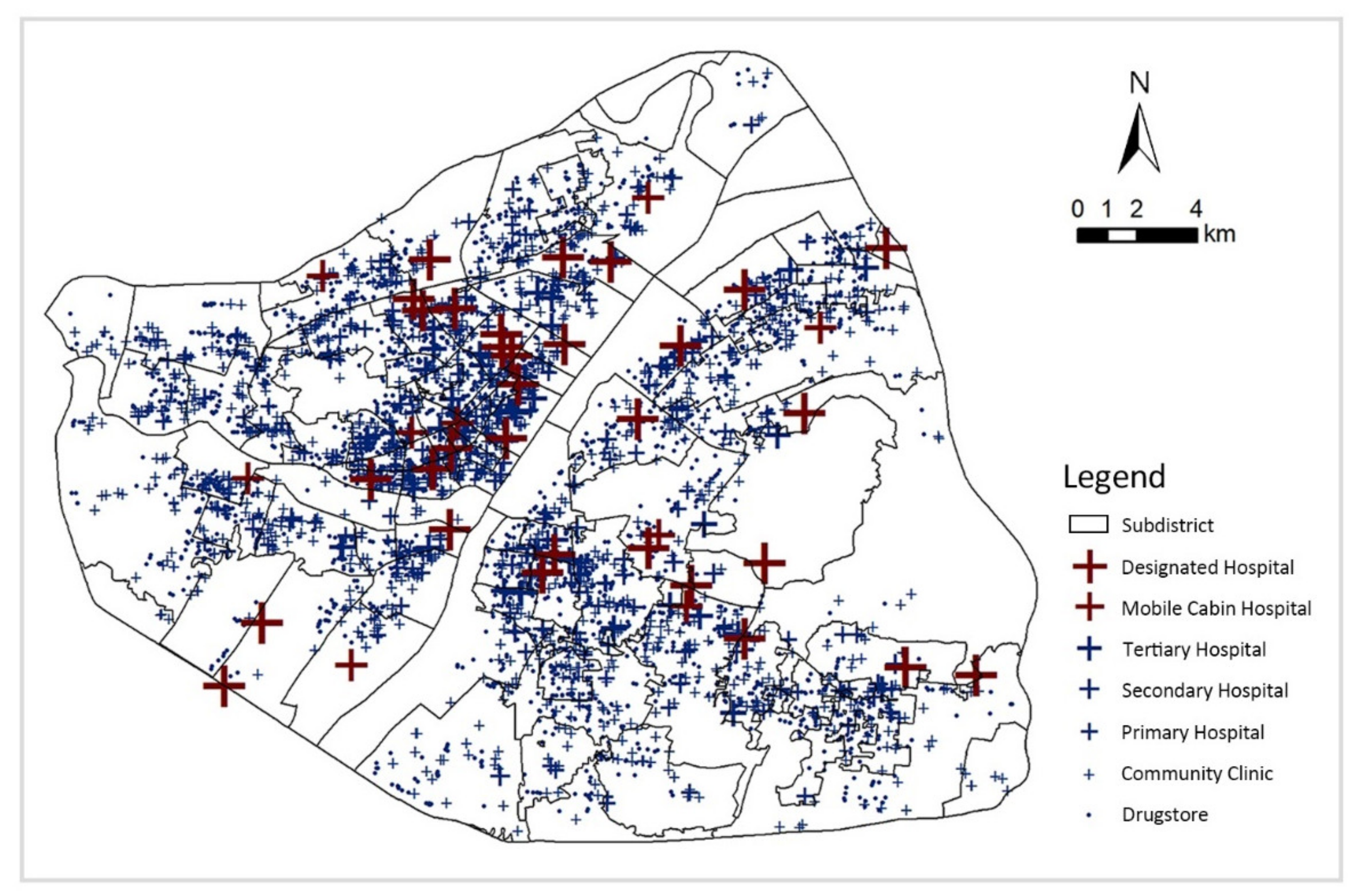
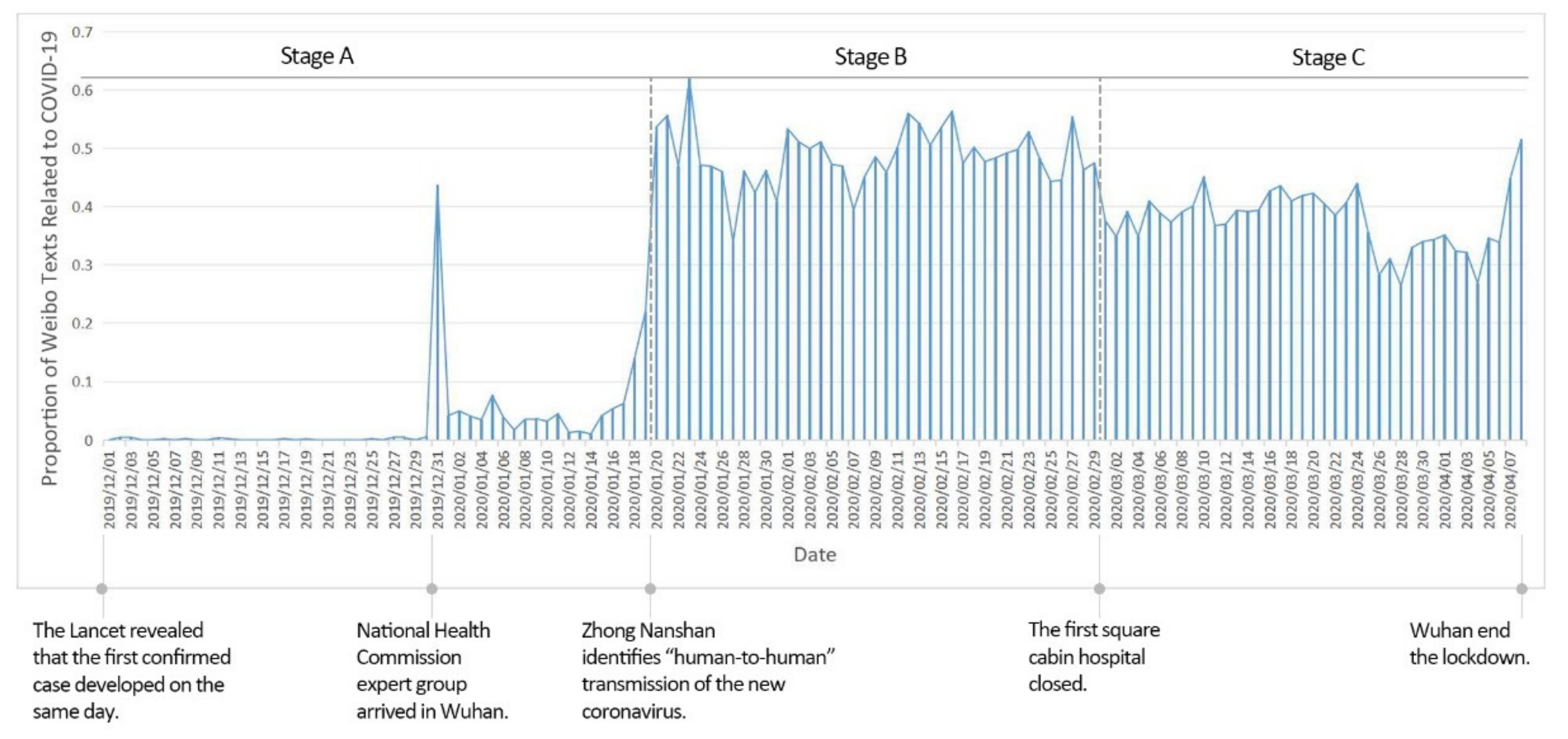
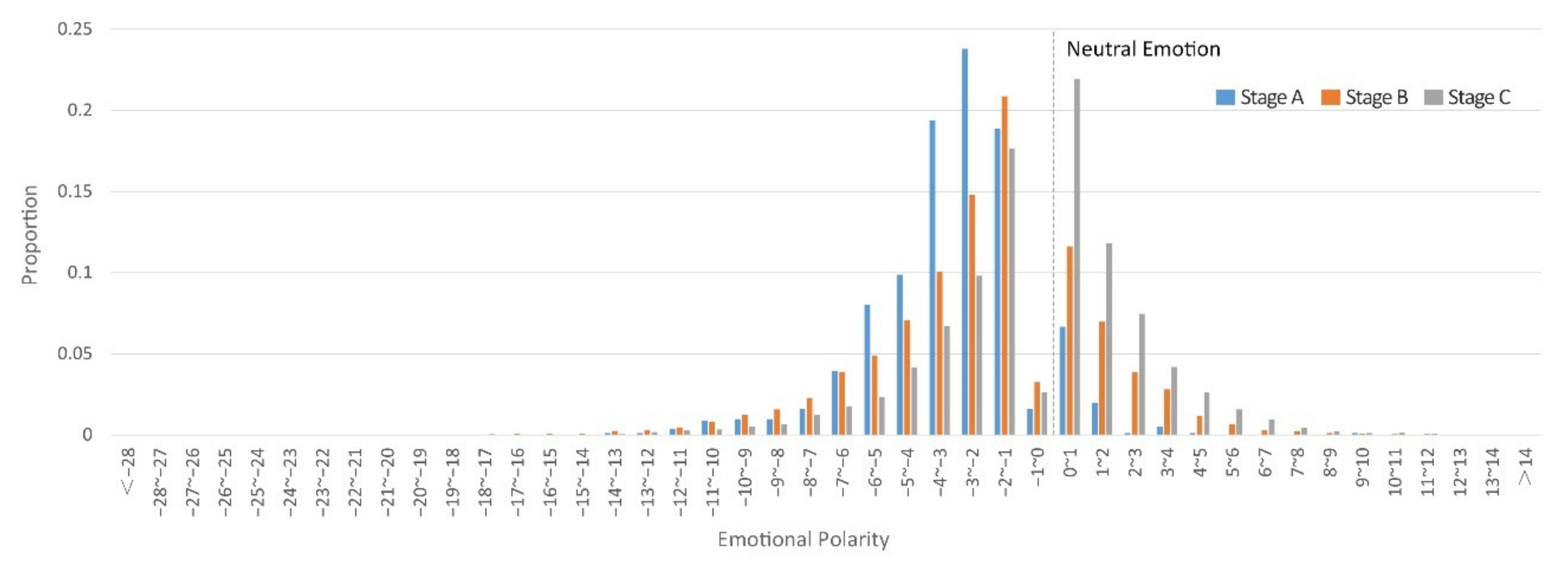
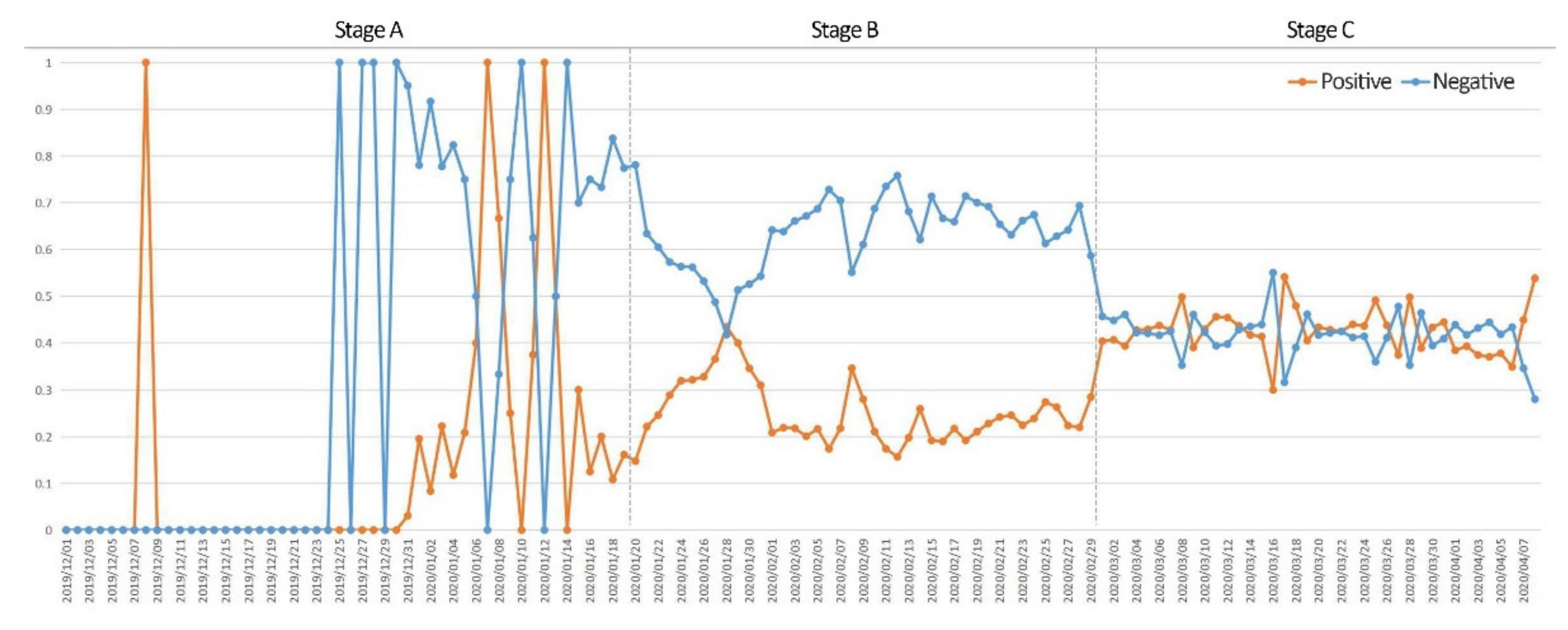
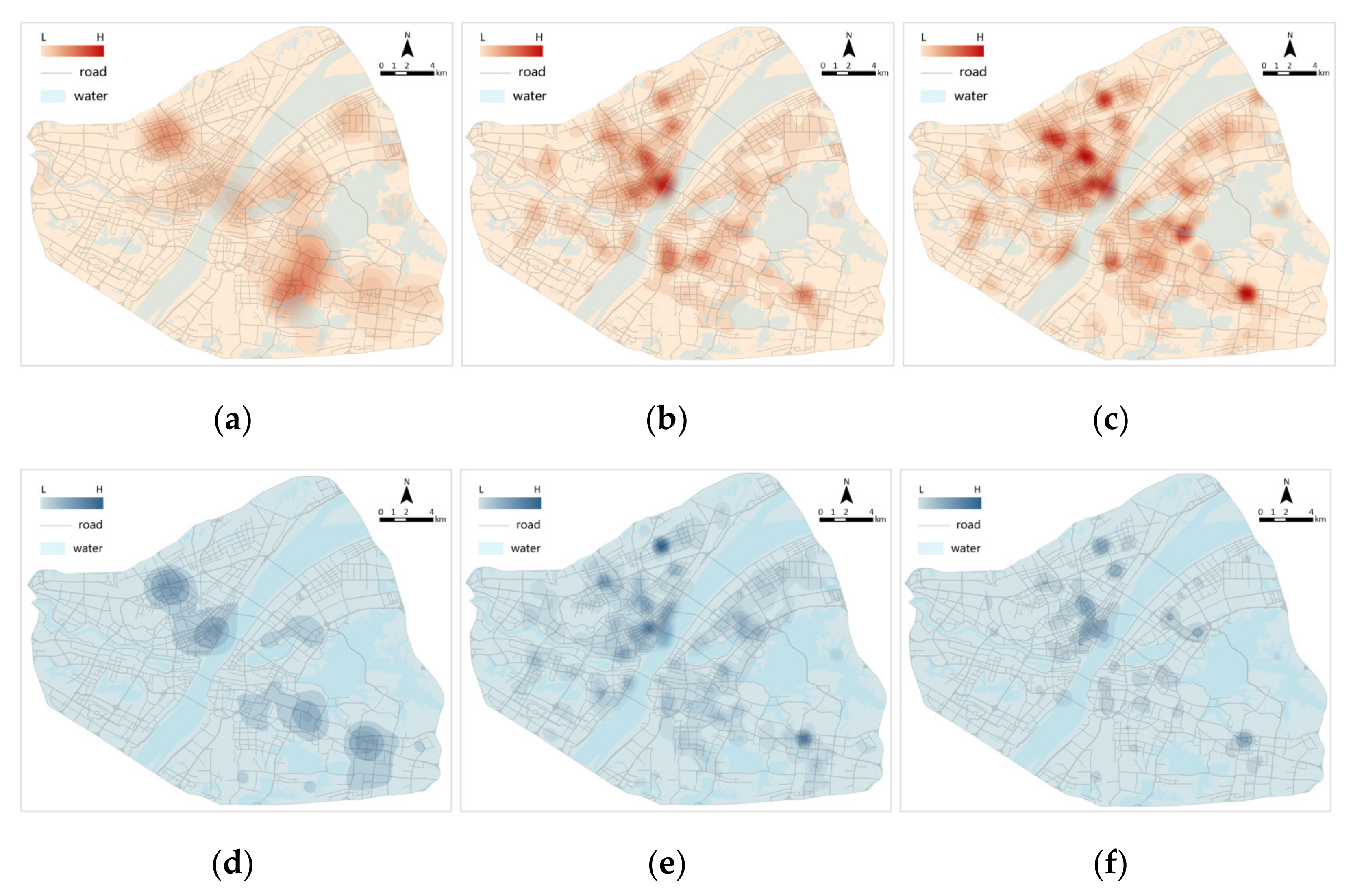
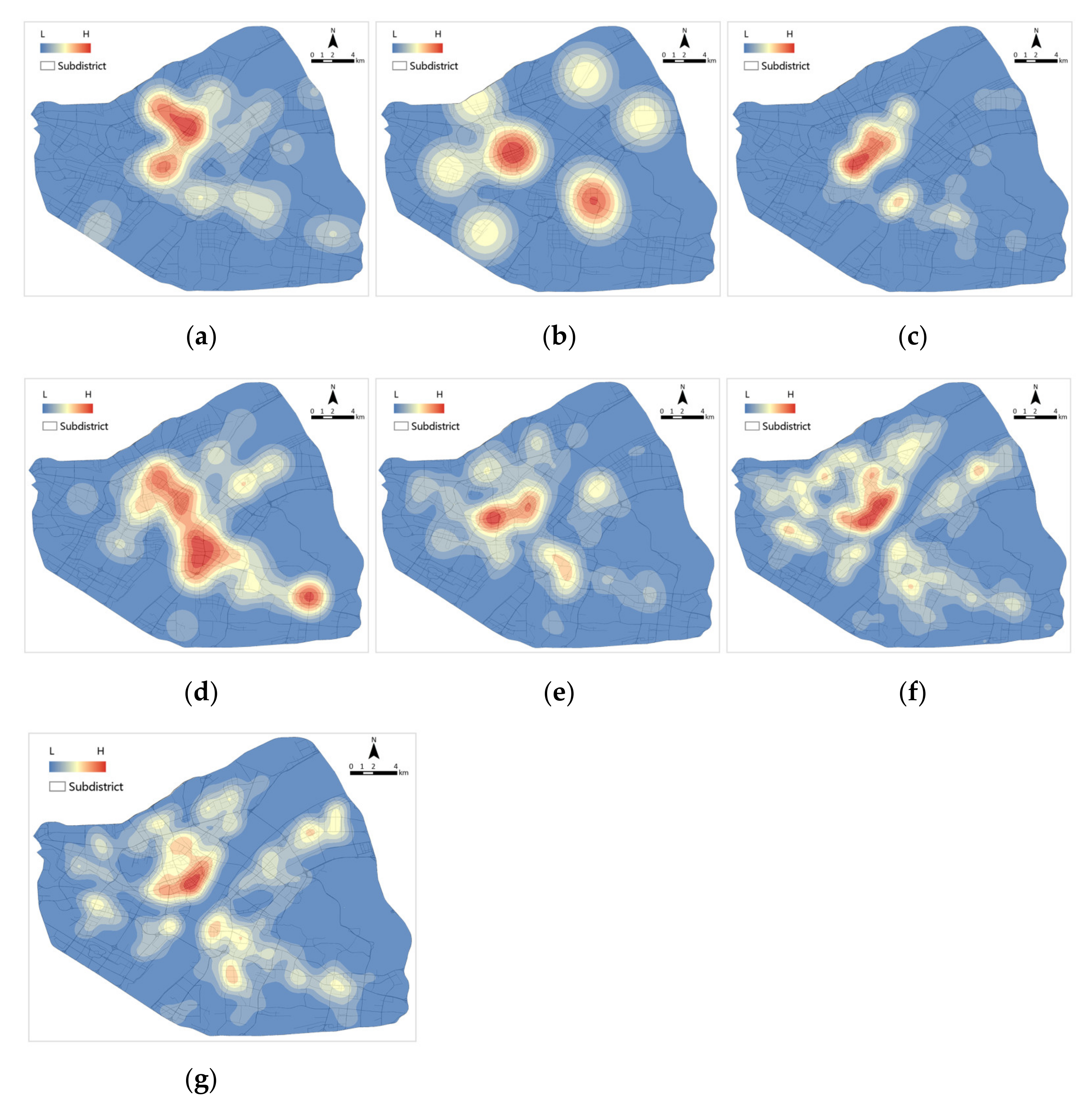
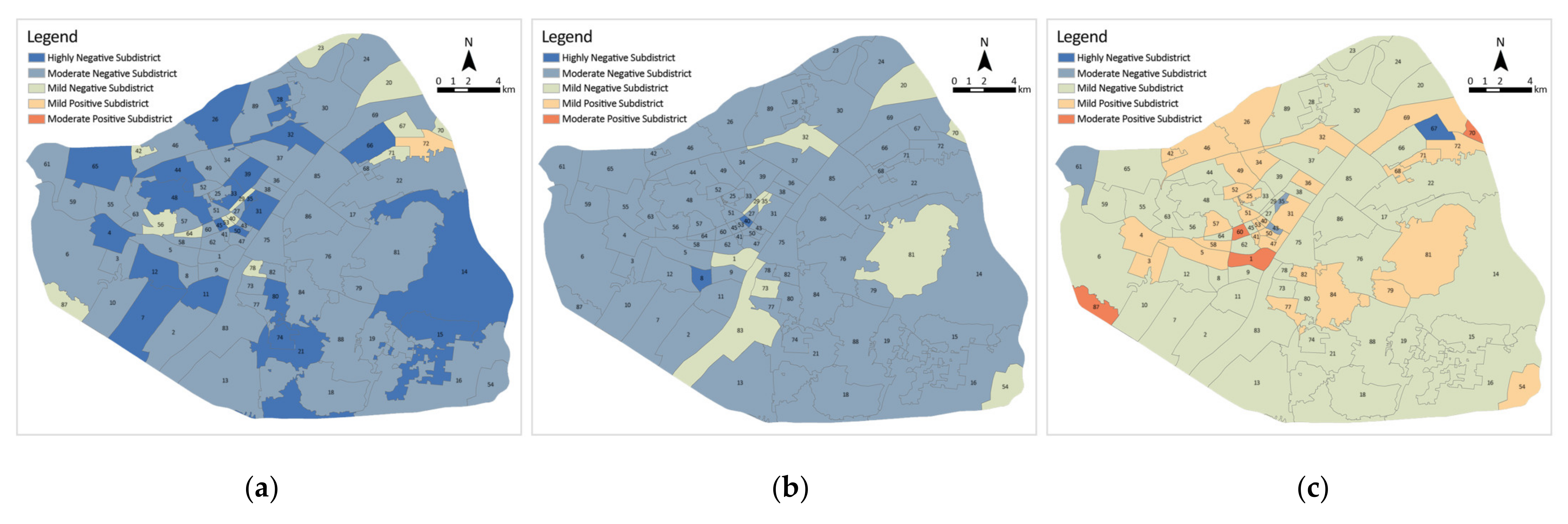

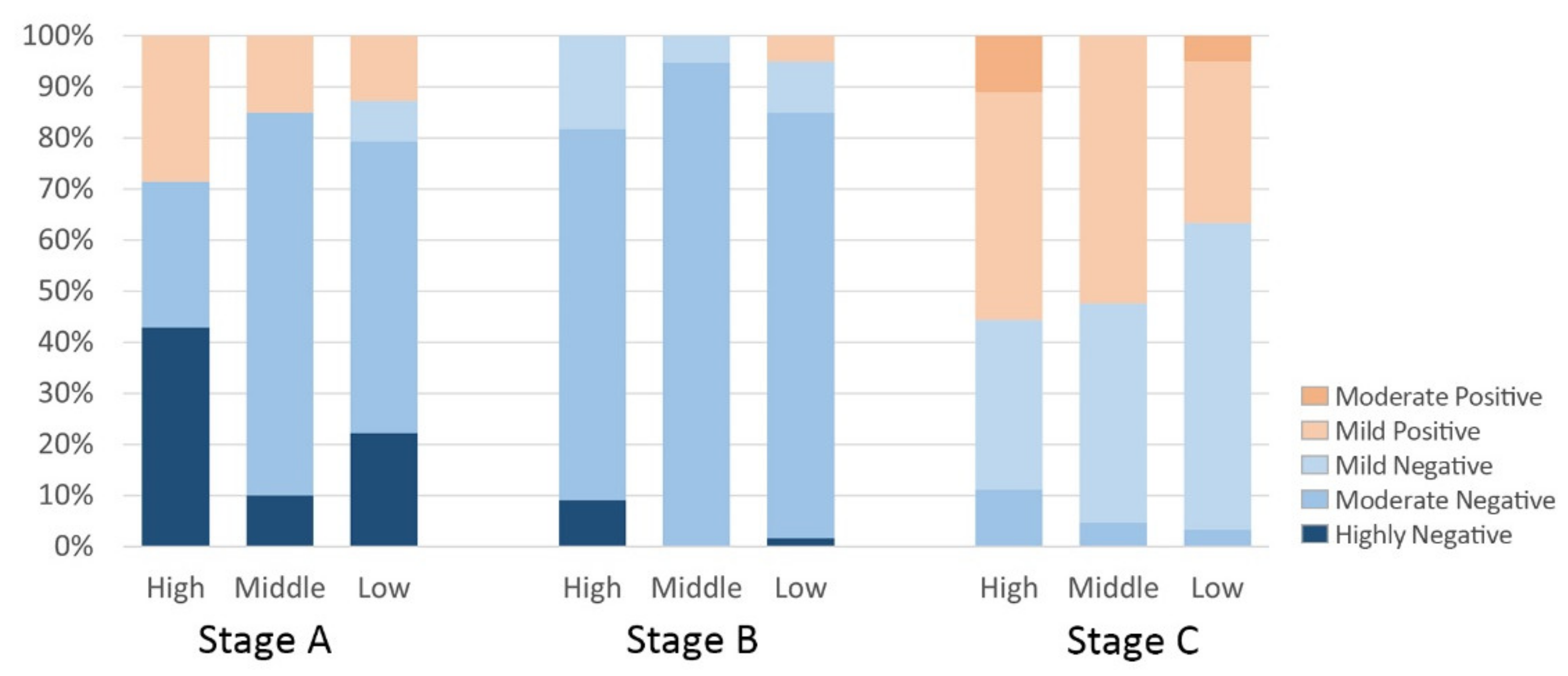


| Word | Length | Word | Length | Word | Length |
|---|---|---|---|---|---|
| lockdown | 1 | seek help | 2 | fever | 1 |
| pneumonia | 1 | severe illness | 2 | hospitalize | 1 |
| diagnosed | 1 | high temperature | 2 | cough | 1 |
| mask | 1 | disinfect | 1 | stranded | 1 |
| quarantine | 1 | nucleic acid | 2 | governance | 1 |
| case | 1 | suspected | 1 | infected person | 2 |
| patient | 1 | cold | 1 | contagion | 1 |
| infect | 1 | heal | 1 | health commission | 2 |
| lift lockdown | 2 | hospital bed | 2 | investigate | 1 |
| virus | 1 | receive | 1 | rehabilitate | 1 |
| new | 1 | health care | 2 | epidemic area | 2 |
| supplies | 1 | donate | 1 | asymptomatic | 1 |
| fangcang | 1 | stay at home | 2 | Huanan | 1 |
| medical staff | 2 | Vulcan hill | 2 | designated hospital | 2 |
| reopen | 1 | symptom | 1 | angel in white | 3 |
| coronavirus | 1 | suspected cases | 2 | Zhong Nanshan | 2 |
| prevention | 1 | treat | 1 | close contact | 2 |
| medical team | 2 | protective clothing | 2 | alcohol | 1 |
| support | 1 | epidemic prevention | 2 | aid | 1 |
| anti-epidemic | 1 | medical personnel | 2 | battle | 1 |
| medical | 1 | illness | 1 | Sars | 1 |
| test | 1 | combating epidemic | 2 | lift a ban | 3 |
| protect | 1 | rush to the rescue | 4 | bailout | 1 |
| Item | Examples |
|---|---|
| Positive emotion words | Come on, salute, happy, moving, [like], [heart] |
| Negative emotion words | Angry, reluctant, ignore, heartache, [tear], [sad] |
| Item | Weight | Examples |
|---|---|---|
| Negative words | −1 | No, abandon, oppose, forbid |
| Adverb of degree word | 0.5 | Mild, slight, light, relatively |
| 0.8 | A little, a bit, some, somewhat | |
| 1.2 | More, so, more and more, comparatively | |
| 1.25 | Very, particularly, extraordinary, so much | |
| 1.5 | Excessively, too, much, overly | |
| 2 | Through and through, fully, most, completely |
| Level of Medical Facilities | Radius of Radiation |
|---|---|
| Tertiary hospital | 1000 m |
| Secondary hospital | 800 m |
| Primary hospital | 500 m |
| Community clinic | 300 m |
| Drugstore | 300 m |
| Fangcang shelter hospital | 1500 m |
| COVID-19 designated hospital | 1500 m |
| Coordinated Development Degree | Level | Scoring Standard |
|---|---|---|
| V1 | High imbalance | 0–0.100 |
| V2 | Serious imbalance | 0.101–0.200 |
| V3 | Moderate imbalance | 0.201–0.300 |
| V4 | Slight imbalance | 0.301–0.400 |
| V5 | Approaching imbalance | 0.401–0.500 |
| V6 | Bare coordination | 0.501–0.600 |
| V7 | Primary coordination | 0.601–0.700 |
| V8 | Moderate coordination | 0.701–0.800 |
| V9 | Favourable coordination | 0.801–0.900 |
| V10 | High coordination | 0.901–1.000 |
| Stage | Medical Facilities |
|---|---|
| Stage A | Tertiary hospital, secondary hospital, primary hospital, community clinic, drugstore |
| Stage B | COVID-19-designated hospital, Fangcang shelter hospital, tertiary hospital, secondary hospital, primary hospital, community clinic, drugstore |
| Stage C | COVID-19-designated hospital, tertiary hospital, secondary hospital, primary hospital, community clinic, drugstore |
Publisher’s Note: MDPI stays neutral with regard to jurisdictional claims in published maps and institutional affiliations. |
© 2022 by the authors. Licensee MDPI, Basel, Switzerland. This article is an open access article distributed under the terms and conditions of the Creative Commons Attribution (CC BY) license (https://creativecommons.org/licenses/by/4.0/).
Share and Cite
Ye, Z.; Li, R.; Wu, J. Dynamic Demand Evaluation of COVID-19 Medical Facilities in Wuhan Based on Public Sentiment. Int. J. Environ. Res. Public Health 2022, 19, 7045. https://doi.org/10.3390/ijerph19127045
Ye Z, Li R, Wu J. Dynamic Demand Evaluation of COVID-19 Medical Facilities in Wuhan Based on Public Sentiment. International Journal of Environmental Research and Public Health. 2022; 19(12):7045. https://doi.org/10.3390/ijerph19127045
Chicago/Turabian StyleYe, Zijing, Ruisi Li, and Jing Wu. 2022. "Dynamic Demand Evaluation of COVID-19 Medical Facilities in Wuhan Based on Public Sentiment" International Journal of Environmental Research and Public Health 19, no. 12: 7045. https://doi.org/10.3390/ijerph19127045
APA StyleYe, Z., Li, R., & Wu, J. (2022). Dynamic Demand Evaluation of COVID-19 Medical Facilities in Wuhan Based on Public Sentiment. International Journal of Environmental Research and Public Health, 19(12), 7045. https://doi.org/10.3390/ijerph19127045





